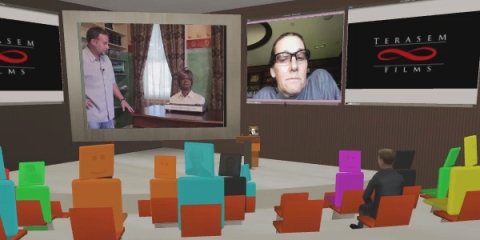Martine Rothblatt gave an ASIM Expert Series talk in Teleplace on “Reconstructing Minds from Software Mindfiles” on Saturday September 18, 2010.
Abstract: “I do think, however, there is a (natural) tendency to way overestimate the importance of copying our brain structure to copying our minds. I think our minds will be uploadable in good enough shape to satisfy most everyone by reconstructing them from information stored in software mindfiles such as diaries, videos, personality inventories, saved google voice conversations, chats, and chatbot conversations. The reconstruction process will be iteratively achieved with AI software designed for this purpose, dubbed mindware.”
Some questions and comments from the audience have been of a philosophical nature and related to preservation of self (whatever that is), but most of those who attended the talk were already prepared to accept that, depending on the amount of information stored and the accuracy of the reconstruction process, the upload copy may be (and feel like) a valid continuation of the original self. The talk and the discussion have been more focused on actual technologies and technical issues: How to extract enough information? How to prove that the information extracted is enough? How to quantify a critical treshold? How to make sure that nothing really important is left behind? How to reconstruct a thinking and feeling mind from a database? Martine gave a detailed presentation of the preliminary implementation of software mindfiles in her twin projects CyBeRev and LifeNaut (similar, but kept separate mainly as a fail-safe measure) and their forthcoming mobile clients and integration with social networks.
See also ASIM Experts series: Reconstructing Minds from Software Mindfiles on carboncopies.org and the discussion in the article MIND and MAN: Getting Mental with Giulio Prisco on H+ Magazine. Martine presented also the short movie Bina48 Robot on YouTube (latest update of the video in the New York Times article).
Thanks Martine for the great talk and thanks to the (about 25) participants who contributed to the discussion with very interesting questions and comments. For those who could not attend we have recorded everything (talk, Q/A and discussion) on video. There are 4 different videos on blip.tv:
VIDEO 1: 600×400 resolution, 1h 21 min, complete
VIDEO 2: 600×400 resolution, 1h 15 min, taken (mostly) from a fixed point of view by Amara Angelica (first few minutes missing)
VIDEO A: 360×240 resolution, 37 min, recorded by Phillip Galinsky, includes 10 min of informal chat before the talk and the first part of the talk
VIDEO B: 360×240 resolution, 47 min, recorded by Phillip Galinsky, includes the last part of the talk and the Q/A and discussion
NOTES: To download the source .mp4 video files from blip.tv, open the “Files and Links” box.
About the speaker: Martine Rothblatt is responsible for launching several satellite communications companies including the first nationwide vehicle location system (Geostar, 1983), the first private international spacecom project (PanAmSat, 1984), the first global satellite radio network (WorldSpace, 1990), and the first non-geostationary satellite-to-car broadcasting system (Sirius, 1990). As an attorney-entrepreneur she also was responsible for leading the efforts to obtain worldwide approval, via new international treaties, of satellite orbit/spectrum allocations for space-based navigation services (1987) and for direct-to-person satellite radio transmissions (1992).
In the 1990s, Dr. Rothblatt entered the life sciences field by leading the International Bar Association’s project to develop a draft Human Genome Treaty for the United Nations (submitted in 1999), and by founding a biotechnology company, United Therapeutics (1996). Dr. Rothblatt is the author of books on satellite communications technology (Radiodetermination Satellite Services and Standards, Artech, 1987), gender freedom (Apartheid of Sex, Crown, 1995), genomics (Unzipped Genes, Temple University Press, 1997) and xenotransplantation (Your Life or Mine, Ashgate House, 2003).
In 2004, Rothblatt launched the Terasem Movement, a transhumanist school of thought focused on promoting joy, diversity, and the prospect of technological immortality via personal cyberconsciousness and geoethical nanotechnology. Through a charitable foundation, leaders of this school convene publicly accessible symposia, publish explanatory analyses, conduct demonstration projects, issue grants, and encourage public awareness and adherence to Terasem values and goals. The purpose of the CyBeRev (cybernetic beingness revival) project of the Terasem Movement is to prevent death by preserving sufficient information about a person so that recovery remains possible by foreseeable technology. If CyBeRev people are recoverable in the future, then they were never really dead in the first place. Real death occurs when information about a person become so disorganized that no technology could restore the original state. This is called the information-theoretic criterion for death. Various definitions of death, such as cessation of heartbeat, have been abandoned as technology (such as defibrillators) demonstrated recovery was possible. The LifeNaut project is an alternative implementation of the same core idea. See also Martine’s blog on Mindfiles, Mindware and Mindclones.
Teleplace is one of the best 3D applications for telework, online meetings, group collaboration, and e-learning in a virtual 3D environment (v-learning).







You must be logged in to post a comment.